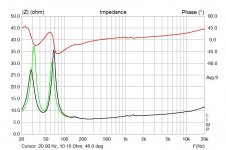That is the problem i think, reality works differently then a plain box simulation. Most box simulations does not take into account where i put the driver and port or where i put the internal damping material. None of the simulation softwares that i have tried have ever showed that the box tuning freq changes if i move the port ever so slightly.
No i do not believe that room gain is a fixed thing, just move any speaker around in a room and you have the answer. But that was not my first question, the question was if a down firing port makes the loudspeaker easier to position in the listening room as some mfr’s claim.
No i do not believe that room gain is a fixed thing, just move any speaker around in a room and you have the answer. But that was not my first question, the question was if a down firing port makes the loudspeaker easier to position in the listening room as some mfr’s claim.
None of the simulation softwares that i have tried have ever showed that the box tuning freq changes if i move the port ever so slightly.
That is about 98.6% correct, the tuning frequency will probably not change much, but the behaviour around port resonance might change slightly, and internal modes escaping through the port will definitely change.
And the internal modes can have a profound influence on the perceived quality of the sound.
the question was if a down firing port makes the loudspeaker easier to position in the listening room as some mfr’s claim.
Sometimes harder, sometimes easier. Depends on the room, and the speaker.
Have you tried hornresp yet?
Hornresp is relatively easy to use, it's free and still under continuous development.
For further information about various quarter wave designs, you should also go to Quarter Wavelength Loudspeaker Design
For further information about various quarter wave designs, you should also go to Quarter Wavelength Loudspeaker Design
